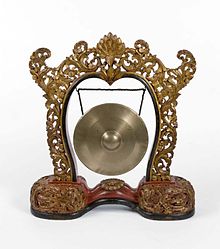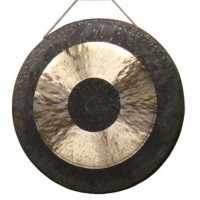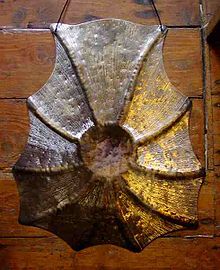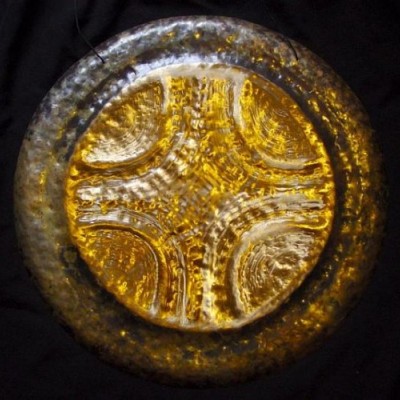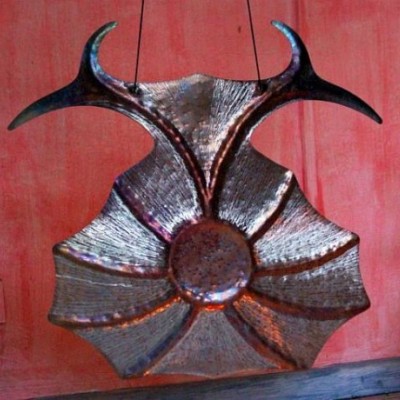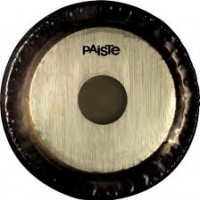What is a gong ?
A gong is a percussion Musical instrument of Chinese origin and manufacture,that takes the form of a flat metal disc which is hit with a mallet, that has spread to Southeast Asia, It's a type of flat bell.
Gongs vary in diameter from about 7 to 80 inches, and they are made of bronze containing a maximum of 78 % of Copper to 22 % of Tin; but in many cases the proportion of tin is considerably less. Such an alloy, when cast and allowed to cool slowly, is excessively brittle, but it can be tempered and annealed in a peculiar manner. If suddenly cooled from a cherry-red heat, the alloy becomes so soft that it can be hammered and worked on the Lathe, and afterwards it may be hardened by re-heating and cooling it slowly. In these properties it will be observed, the alloy behaves in a manner exactly opposite to steel, and the Chinese avail themselves of the known peculiarities for preparing the thin sheets of which gongs are made. They cool their castings of bronze in water, and after hammering out the alloy in the soft state, harden the finished gongs by heating them to a cherry-red and allowing them to cool slowly. These properties of the alloy long remained a secret, said to have been first discovered in Europe by Jean Pierre Joseph d'Arcet at the beginning of the 19th century. Riche and Champion are said to have succeeded in producing tam-tams having all the qualities and timbre of the Chinese instruments. The composition of the alloy of bronze used for making gongs is stated to be as follows: Copper, 76.52; Tin, 22.43; Lead, 0.26; Zinc, 0.23; Iron, 0.81. The gong is beaten with a round, hard, leather-covered pad, fitted on a short stick or handle. It emits a peculiarly sonorous sound, its complex vibrations bursting into a wave-like succession of tones, sometimes shrill, sometimes deep.
Gongs are broadly of three types. Suspended gongs are more or less flat, circular discs of metal suspended vertically by means of a cord passed through holes near to the top rim.
Bossed or nipple gongs have a raised centre boss and are often suspended and played horizontally, mostly these are tuned to a specific note.
Bowl gongs are bowl-shaped, and rest on cushions and belong more to bells than gongs. Gongs are made mainly from bronze or brass but there are many other alloys in use.
Gongs produce two distinct types of sound. A gong with a substantially flat surface vibrates in multiple modes, giving a "crash" rather than a tuned note. This category of gong is sometimes called a tam-tam to distinguish it from the bossed gongs that give a tuned note. In Indonesian gamelan ensembles, some bossed gongs are deliberately made to generate in addition a beat note in the range from about 1 to 5 Hz. The use of the term "gong" for both these types of instrument is common
Types of gong
Suspended gongs are played with beaters and are of two main types: flat faced discs either with or without a turned edge, and gongs with a raised center boss. In general, the larger the gong, the larger and softer the beater. In Western symphonic music the flat faced gongs are generally referred to as tam-tams to distinguish them from their bossed counterparts, although the term "gong" is correct to use for either type. The gong has been an ancient Chinese custom for many eras. They were first used to signal peasant workers in from the fields as some gongs are loud enough to hear from up to 50 miles away. In Japan, they are used to start the beginning of sumo wrestling contests.
Large flat gongs may be 'primed' by lightly hitting them before the main stroke, greatly enhancing the sound and causing the instrument to "speak" sooner, with a shorter delay for the sound to "bloom". Keeping this priming stroke inaudible calls for a great deal of skill. The smallest suspended gongs are played with bamboo sticks, or even western-style drumsticks. Contemporary & avant-garde music, where different sounds are sought, will often use friction mallets (producing squeals & harmonics), bass bows (producing long tones and high overtones), and various striking implements (wood/plastic/metal) to produce the desired tones.
Traditional suspended gongs
chau gong
By far the most familiar to most Westerners is the chau gong or bullseye gong. Large chau gongs, also called tam-tams
have become part of the symphony orchestra. Sometimes a chau gong is referred to as a Chinese gong, but in fact it is only one of many types of suspended gongs that are associated with China.
The chau gong is made of copper-based alloy, bronze or brass. It is almost flat except for the rim, which is turned up to make a shallow cylinder. On a 10" gong, for example, the rim extends about a half an inch perpendicular to the gong surface. The main surface is slightly concave when viewed from the direction to which the rim is turned. The centre spot and the rim of a chau gong are left coated on both sides with the black copper oxide that forms during the manufacture of the gong, the rest of the gong is polished to remove this coating. Chau gongs range in size from 20" to 40" in diameter.
The earliest Chau gong is from a tomb discovered at the Guixian site in the Guangxi Zhuang Autonomous Region of China. It dates from the early Western Han Dynasty. They were known for their very intense and spiritual drumming in rituals and tribal meetings.
Traditionally, chau gongs were used to clear the way for important officials and processions, much like a police siren today. Sometimes the number of strokes on the gong was used to indicate the seniority of the official. In this way, two officials meeting unexpectedly on the road would know before the meeting which of them should bow down before the other.
Uses of gongs in the symphony orchestra
Gioachino Rossini, Richard Wagner and Vincenzo Bellini were some of the first composers to use the gong in their works; Rossini in the final of act 3 of Armida (1817), Bellini in Norma (1831) and Wagner in Rienzi (1842). Within a few decades the gong became an important member of the percussion section of a modern symphony orchestra. Fine examples of its use are demonstrated in the symphonies of Gustav Mahler, Dmitri Shostakovich and, to a lesser extent,Sergei Rachmaninov. Karlheinz Stockhausen used a 60" Paiste gong in his Momente. Puccini used both Gongs and Tam-tams in his Operas.
The gong has been effectively used in the orchestra to intensify the impression of fear and horror in melodramatic scenes. The tam-tam was first introduced into a western orchestra by Francois Joseph Gossecin the funeral march composed at the death of Mirabeau in 1791. Gaspare Spontini used it in La Vestale (1807), in the finale of Act II, an impressive scene in which the high pontiff pronounces the anathema on the faithless vestal. It was also used in the funeral music played when the remains of Napoleon were brought back to France in 1840. Meyerbeer made use of the gong in the scene of the resurrection of the three nuns in Robert le diable. Four tam-tams are now used at Bayreuth in Parsifal to reinforce the bell instruments, although there is no indication given in the score. The tam-tam has been treated from its ethnographical side by Franz Heger. In more modern music, the tam-tam has been used by composers such as Karlheinz Stockhausen in Mikrophonie l (1964–65) and by George Crumb. Crumb expanded the timbral range of the tam-tam by giving performance directions (in Makrokosmos III: Music For A Summer Evening, composed in 1974) such as using a "well-rosined contrabass bow" to bow the tam-tam, producing an eerie harmonic sound, while Stockhausen exploited amplification (via hand-held microphones) of a wide range of scraping, tapping, rubbing, and beating techniques using unconventional implements (plastic dishes, egg timer, cardboard tubes, etc.). Gongs can also be immersed into a tub of water after being struck. This is called "water gong" and is called for in several orchestral pieces.
Big Nipple Gong
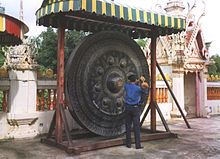
A very large nipple gong at a Buddhist temple in Roi Et, Isan, Thailand
A nipple gong has a central raised boss or nipple, often made of a different metal to the rest of the gong. They have a clear resonant tone with less shimmer than other gongs, and two distinct sounds depending on whether they are struck on the boss or very close to it. They are most often tuned to various pitches.
Nipple gongs range in size from 6" to 14" or larger. Sets of smaller, tuned nipple gongs can be used to play a tune.
Nipple gongs are used in Chinese temples for worship.
Opera gongs

An essential part of the orchestra for Chinese opera is a pair of gongs, the larger with a descending tone, the smaller with a rising tone. The larger gong is used to announce the entrance of major players, of men, and to identify points of drama and consequence. The smaller gong is used to announce the entry of lesser players, of women, and to identify points of humour.
Opera gongs range in size from 7" to 12", with the larger of a pair one or two inches larger than the smaller.
Pasi gongs
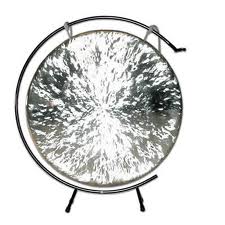
A Pasi gong is a medium-size gong 12" to 15" in size, with a crashing sound. It is used traditionally to announce the start of a performance, play or magic. Construction varies, some having nipples and some not, so this type is named more for its function than for its structure or even its sound.
Pasi gongs without nipples have found favour with adventurous middle-of-the-road kit drummers.
Tiger gong
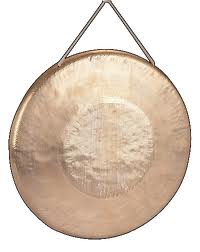
A tiger gong is a slightly descending or less commonly ascending gong, larger than an opera gong and with a less pronounced pitch shift. Most commonly 15" but available down to 8".
Shueng Kwong

A Sheng Kwong gong is a medium to large gong with a sharp Staccato sound.
Wind gong
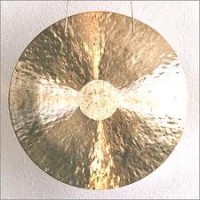
Wind gongs (also known as Feng or Lion Gongs) are flat bronze discs, with little fundamental pitch, heavy tuned overtones, and long sustain. They are most commonly made of B20 bronze, but can also be made of M63 brass or NS12 nickel-silver. Traditionally, a wind gong is played with a large soft mallet, which gives it a roaring crash to match their namesake. They are lathed on both sides and are medium to large in size, typically 15" to 22" but sizes from 7" to 40" are available. The 22" size is most popular due to its portability and large sound. They are commonly used by drum-kit drummers in rock music.
Played with a nylon tip drumstick they sound rather like the coil chimes in a mantle clock. Some have holes in the centre, but they are mounted like all suspended gongs by other holes near the rim. The smaller sizes (7"-12") have a more bell-like tone due to their thickness and small diameter.
Sculptural Gongs
Sculptural gongs made by Steve Hubback
Sculptural gongs (also known as Gong Sculptures) are gongs which serve the dual purpose of being a musical instrument and a work of visual art. They are generally not disc shaped, but instead take more complex, even abstract forms. Sculptural gongs were pioneered in the early 1990s by Welsh percussionist and metal crafter, Steve Hubback, who was partially inspired by the work of the French Sound Sculptors, Francois and Bernard Baschet.
Hubback's works have been used by many musicians including solo percussionist Dame Evelyn Glennie and rock drummer Carl Palmer.
English gong and Cymbal maker, Matt Nolan,partially inspired by the work of Hubback, also creates Sculptural gongs of his own design or to private commission.
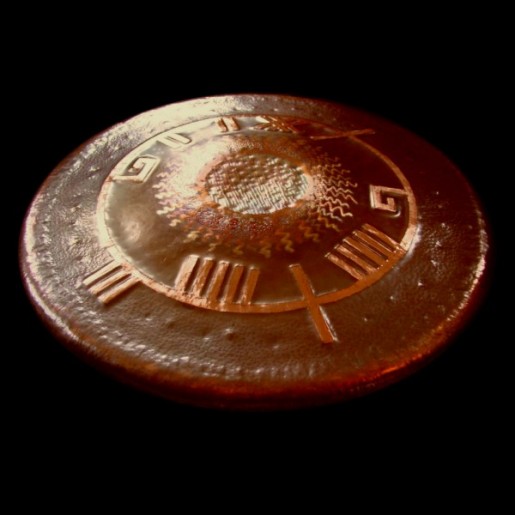
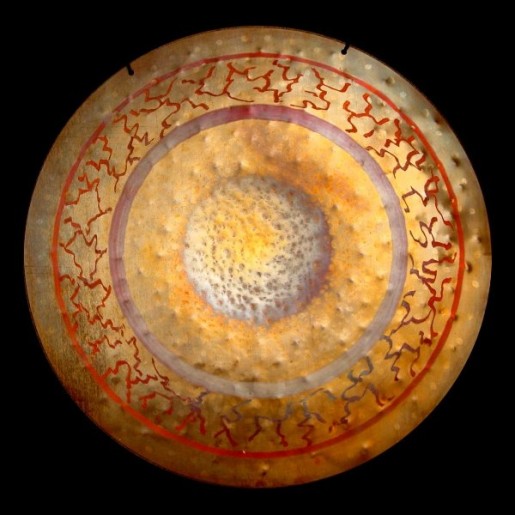
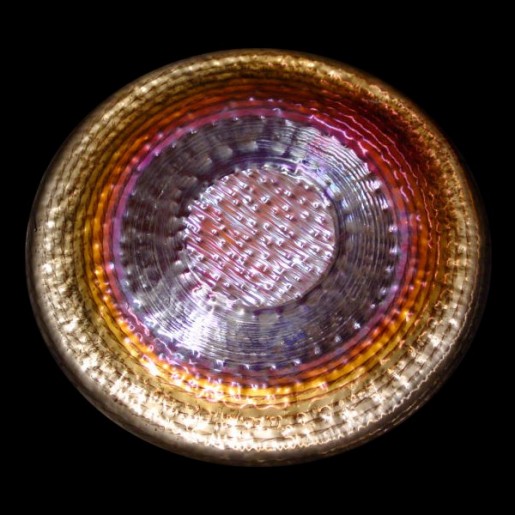
Sculptural gongs made by Matt Nolan.
Indonesian gamelan ensembles of instruments.
In Indonesian gamelan ensembles, instruments that are organologically gongs come in various sizes with different functions and different names. For example, in the central Javanese gamelan, the largest gong is called gong ageng, ranges in size up to 1 meter in diameter, has the deepest pitch and is played least often; the next smaller gong is the gong suwukan or siyem, has a slightly higher pitch and replaces the gong ageng in pieces where gong strokes are close together; the kempul is smaller still, has a higher pitch, and is played more frequently. The gong ageng and some gong suwukan have a beat note.
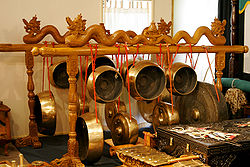
A gong collection in a Gamelan ensemble of instruments - Indonesian Embassy Canberra.
An agung
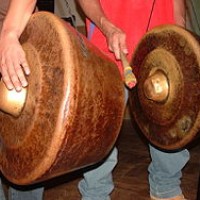
An Agung, is a type of Philippines hanging gong used as part of the Kulintang ensemble.
Paiste range of gongs
The Paiste Symphonic gong.
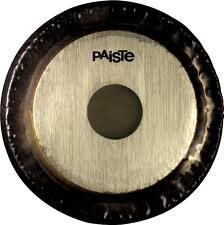
The Paiste Symphonic is the oldest version of thier gong, Paiste Symphonic Gongs have a slightly raised surface with a harmonic and universal sound structure. The fundamental note of the gong is balanced with the instrument's complex overtones. A Paiste Symphonic is a good starting point for a gong collection, the Symphonic contains even proportions of various gong characteristics, which can be brought forth using different mallets and striking points. Symphonic Gongs feature some of our largest examples of the instrument, like the 60" SGM and the extraordinary 80", the world's largest gong.
These come in Sizes: 20" - 22" - 24" - 26" - 28" - 30" - 32" - 34" - 36" - 38" - 40" - 50" - 60" - 80"
Paiste Planet gong.
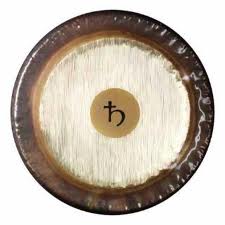
Paiste Planet Gongs resemble Symphonic Gongs in character, but they feature a strong fundamental note tuned to represent a natural harmonic series based on the orbital properties of the Sun, the Earth, the Moon and the other planets as calculated by Hans Cousto. Planet Gongs resonate harmonically with the cycles of the cosmos, communicating to us what has been known since antiquity as the "music of the spheres". Mysterious in sound color, Planet Gongs convey an unusual atmosphere.
Deco Paiste gong.
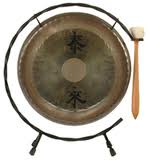
Deco Paiste gongs is very much like a miniature Symphonic Gong. The instrument produces a fascinating and wonderfully exotic sound. True gongs with complex harmonics, make a unique and decorative addition to your personal or musical environment. These come in Sizes: 7" - 10" -13"
Accent Paiste gong.
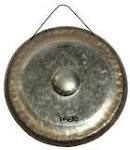
Accent Gongs are special gongs with an aggressive, foaming, and lively sound character. A multitude of sounds may be achieved with various playing techniques. Accent Gongs are available in four sizes 7" - 10" -13" - 24"
Paiste sound creation gong.

Each Sound Creation Gong has its own extraordinary and particular sound character. Their impressive, charismatic sound embodies a wealth of exemplary emotional sensations and feelings. Due to their varied sound colors and voices, these instruments also offer a wide range of harmonics and frequencies.
The Sound is explained as Unfathomable and dark, with swelling highs.
An Unusal gong is the Rock gong.
Rock gong
Rock gongs are large stones struck with smaller stones to create a metallic resonating sound.
Rock gongs have been found in various African locations, such as sites in Burkina Faso, Niger,Nigeria, Sudan,Uganda and Zambia.TheKupgal petroglyphsite in India, which was originally discovered in 1892 (though lost and rediscovered in the 21st century), includes a large number of rock gongs alongside rock art. The site dates to theNeolithicperiod.
Rock gongs were brought to the attention of the anthropological community in 1956 by archaeologist Bernard Fagg.Fagg identified that the first recorded discovery of rock gongs (or "ringing rocks used for the production of musical notes") was in Birnin Kudu, Nigeria, in June 1955.He drew a link between the geographic distribution of rock gongs and cave paintings, stating that the gongs' proximity to cave paintings "leaves [sic] little doubt that they are associated in some way".
Rock gongs are often large doleriterocks;Fagg describes examples that weigh up to several tons. They are almost always entirely solid, as playing rocks in other such states would result in a hollow and less metallic tone.Bernard Fagg identifies that the tone produced by the vibrating rock is not necessarily influenced by the size of the rock, provided that the resonating stone is not dampened by the solid earth.
Rock gongs would be played by striking the rock's surface with a hand-held stone. This beater would often be made of igneousstone, but examples of metamorphic quartzite beaters have been discovered.
Although often played solo, gongs can be played as an esemble, with evidence that gongs for four players were sometimes used.These larger stones can have up to 50 tuned depressions.When measured against a Ragg tuning fork, a depression on one particular gong was found to have a fundamental frequencyof 216 Hz.
Continuous playing of the instrument produces smooth indentations in the rock and amatt-like texture.
Gong manufacturers
Besides many traditional and centuries old manufacturers in places such as China, Tibet, Burma, Korea, Indonesia, and the Philippines, since the 20th Century gongs have also been made in Europe and America.
Paiste are the largest non-Asian manufacturer of gongs. This Swiss company of Estonian lineage makes gongs at their German factory. Also in Europe, Italian company UFIP make a range of gongs at their factory in pistoia.
In North-America,Sabian make a small number of gongs and Zildjian sell Zildjian-branded gongs which have in the past been made by Zildjian, but current production looks to be Chinese in origin.
Some of the smaller Turkish cymbal companies have also been seen to dabble in gongs but very much as a side-line to their core business of hand-hammered cymbals.
More unusual and innovative types of gong have been made in recent years by independent gong smiths, most notably Steve Hubback, Michael Paiste (who is now independent of the family business) and Matt nolan.
Gongs in popular culture
Gongs have been used in upper class households as waking devices, or to summon domestic help.
The Space rock group "Gong"were named after the Instrument.
T. Rex (Marc Bolan) had a hit song on his album Electric Warrior called Get it On (Bang a Gong).
A man hitting a gong twice starts all Rank films. This iconic figure is known as the "gongman".
The Moody Blues' landmark album Days of Future Passedopens with a crescendo roll on tam-tam, and closes with a single stroke which fades to silence.
Queen's classic song "Bohemian Rhapsody" ends with the sound of a massive tam-tam.
Roger Taylor is known for having one of the biggest tam-tams in rock.
A gong is played in the song "What is and what Should Never Be" by Led Zeppelin. The gong is also the last instrument played in the live version of "Whole Lotta Love".
A gong is also played at the end of the song "Dream On" by Aerosmith.
A gong was the titular feature on The Gong Show, a television Variety Show or game show spoof broadcast in the United States in three iterations (1976–80, 1988–89,2008). The gong was used to signal the failure of an act by the show's panel.
Carl Palmer used a gong during the Emerson, Lake and Palmersong Tank. His drum kit has 2 gongs and uses them frequently during his drum solos live.
Neil Peart used a gong at the end of the Rushsong Hemispheres.
Roger Waters used a gong on stage with Pink Floydin concerts from 1967-1973 on "A Saucerful of Secrets" and "Set the controls for the Heart of the Sun". The latter was when the gong would burst into flames during live performances.
Pink Floyd: Live at Pompeii contains dramatic scenes of Waters striking a large gong.
In the British military "gong" is slang for a medal.
The "sun gong" used in the annual Paul Winter Winter Solstice Celebration held at the Cathedral of Saint John, New Yorkis claimed to be the world's largest tam tam gong at 7 feet in diameter.
Morrissey's drummers have used a gong in many of his live shows since 2005 to dramatically end songs.
Toto make use of a gong several times in their song "Africa".
Keith Moon's drum kit frequently included a gong.
Supertramp used a water gong in the title song of their 1974 album Crime of the Century.

